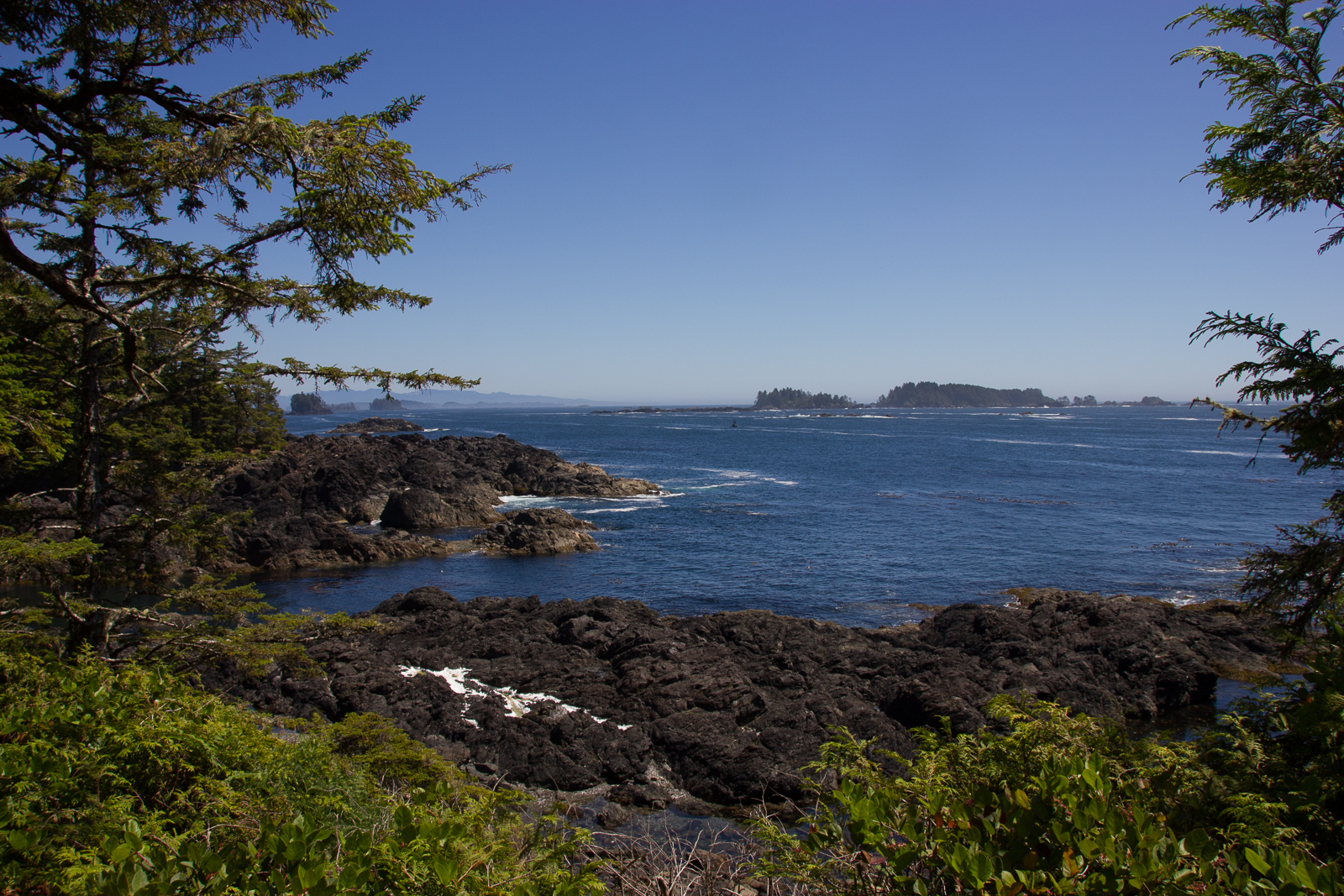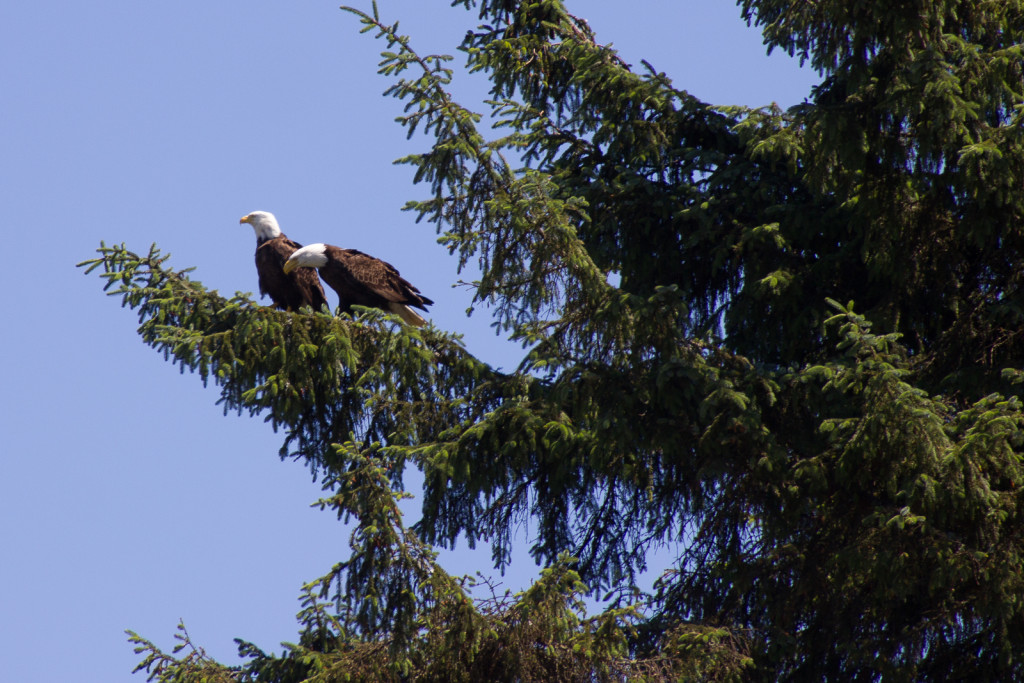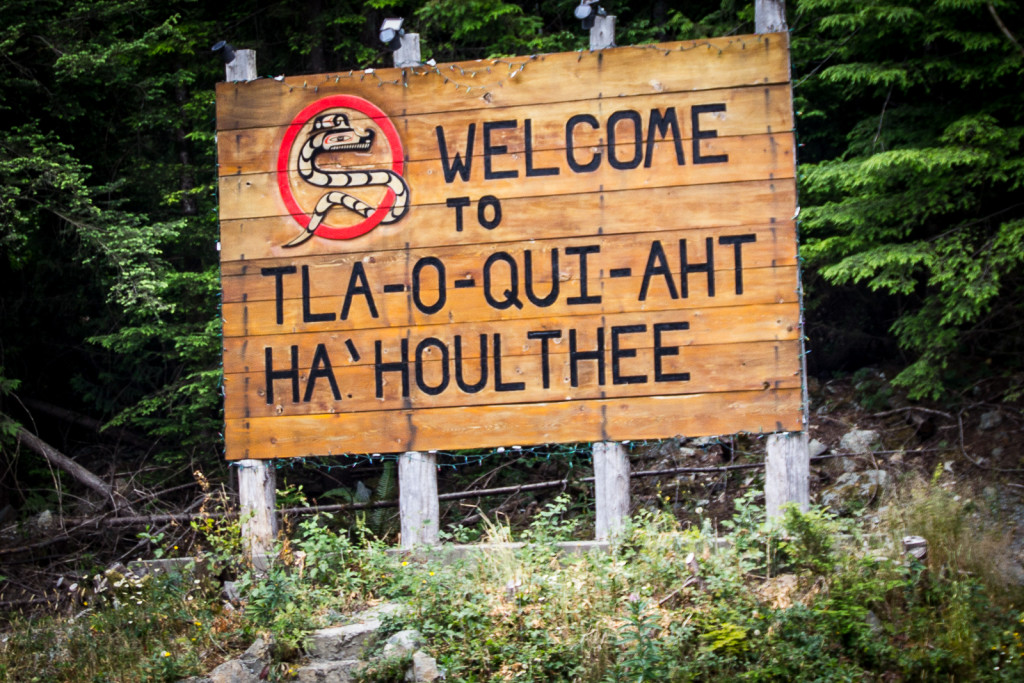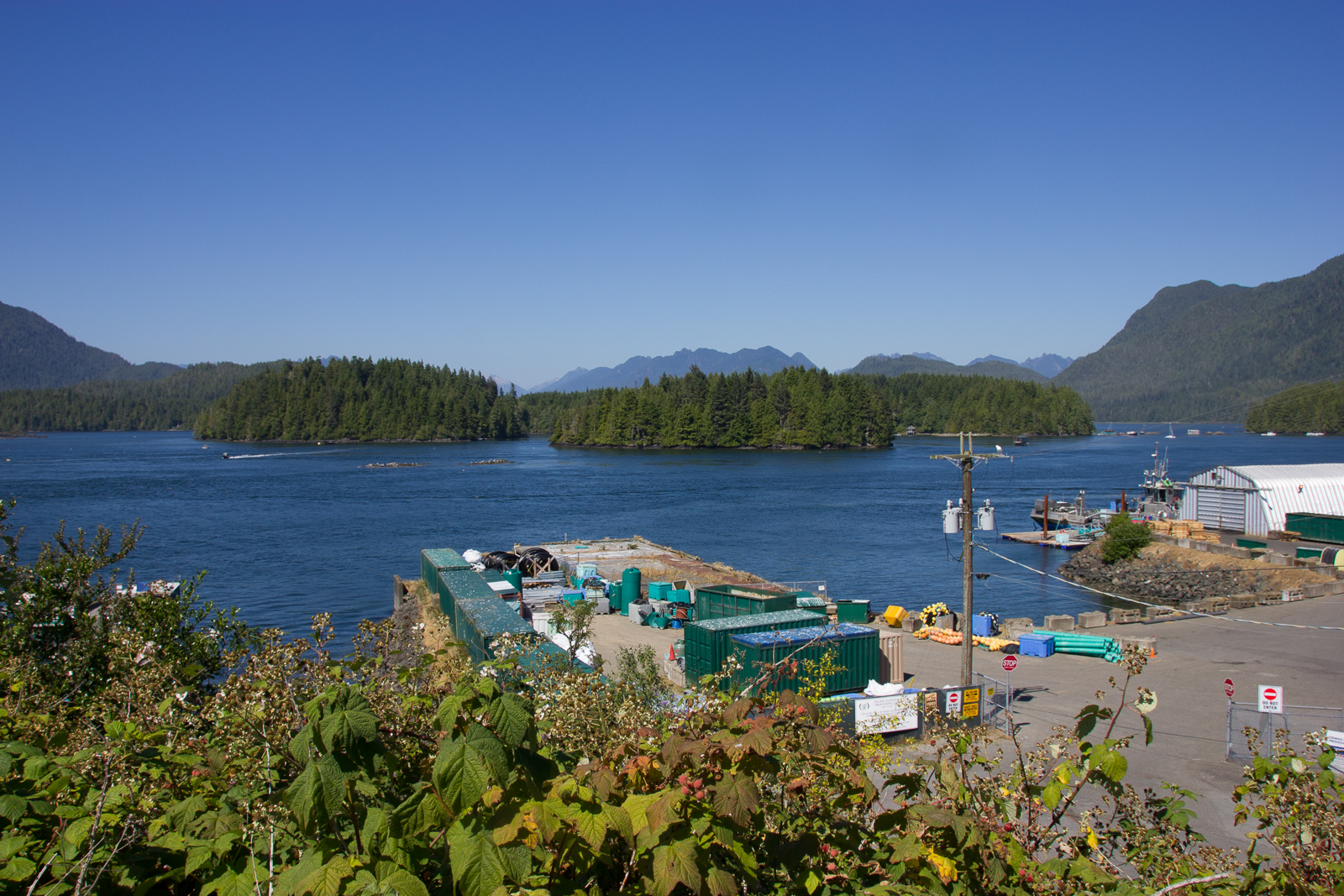
We had stayed in the USA for about four months and finally it was time to explore it’s northerly neighbor Canada. I was very curious about Canada since I wanted to see if it is anything like I imagined it to be. I have to say that I was a little bit disappointed with the USA in one regard. I had expected it to still be the country of endless freedom where you wouldn’t feel or see any boundaries but just travel through vast areas of open land and uninhabited nature. That isn’t really the case anymore. Yes, there are big National Parks, National Forests and Wilderness areas – especially in the western states – and compared to the tiny and congested Germany there’s not a lot of people to be found in many parts but still I hadn’t found what I was looking for. So I had my sights set on Canada, the world’s second biggest country in terms of the area that it covers but with only less than half of the inhabitants that Germany has (Germany about 80 million, Canada about 35 million). In the northern half of Canada there are large areas where there aren’t any roads and the only way to get there is by boat or more often by floatplane – a typical Canadian thing. As one Canadian said to me: “We could put the whole of Germany somewhere up in the north of Canada and never even notice that it’s there!”. Janina had been to Canada before but I wanted to see what it was all about so we took the ferry from Port Angeles to Vancouver Island.
After a bit more than an hour’s drive on the ferry we arrived in Victoria, British Columbia. This was our second to last border crossing and we came prepared. We had printed out proof that we could support ourselves for a few months, that we had already booked a flight back home, that I still have job in Germany to go back to and everything else that an immigration officer might want to check. We rolled up to the little booth where the officer sat and weren’t even asked to get out of our camper or kill the engine. The guy just asked us if the car was rented and if we had any weapons with us. After that was of out the way our passports were stamped and we were welcomed to Canada – just like that. We were quite surprised that our entry had been so quick and uneventful. There was also something else about Vancouver Island that we absolutely hadn’t expected – it was freaking hot with more than 30° Celsius! Since Janina had read that it rarely would get above 20° there we had gotten ourselves some warm clothes in advance but suddenly we were sweating in a heat like we hadn’t experienced since Mexico.

We had heard good things about Victoria, B.C. but to be honest I wasn’t really interested in seeing another city. I wanted to get out into nature since people who had been there had told us that Vancouver Island would be exceptionally beautiful. Nevertheless we set off on foot as usual and wandered around Victoria. We skipped on the Royal British Columbia Museum since we didn’t want to pay the high entrance fee of more than 20 dollars per person, but rather had a look at the little food-cart festival going on behind the museum. By the way – it’s a “royal” museum since Canada had been part of the British Empire and even today as an independent nation the official head of state is still Queen Elizabeth II. On the ferry we had already spotted her picture hanging on the wall and her image also appears on the Canadian coins.
Victoria is a pretty city and we liked it’s distinct british flair that one could notice in the architecture, the red two-story busses, all the tea houses or the fact that the five o’clock tea is nowhere taken more seriously than there. We just weren’t very interested in exploring another city at that time so we spontaneously decided to leave at the same day and try to see some more of the island. Since we hadn’t wanted to pay for the museum we thought we could visit some other place along the way and we were passing the famous Butchart Gardens anyway. Only that they thought it OK to charge more than 30 Dollars per head there to get in – for a garden. So we told the girl at the entrance that we had changed our mind and just want to leave again and ended up paying the Butterfly Gardens a visit. That was quite nice since they also had some parrots there and one of the Eclectus parrots proved himself to be very curious about people and not shy at all. It has to be said though that this place also charged way more than they should have in our view since you get to see only one small hall with some birds, butterflies and turtles there. It was just another “tourist trap”.
In a bookstore in Victoria we had gotten ourselves the book “Camp free in B.C.” and we had picked one of the places it mentioned as our first stay. So we drove to the Cowichan lake to a small and inexpensive campground for our first night in Canada. That should remain the only occasion where we had to pay for accommodation for the next few weeks to come. The book had some part in that although it did a better job in annoying us with it’s travel directions (we just hope the authors just put in some GPS coordinates in the next edition!). Even if you don’t buy a book like we did or a backcountry roads map it’s really very easy to find a spot for dry-camping in British Columbia.
The next day we drove to Nanaimo to access the internet and then headed on to Port Alberni. Eventually we would reach the west coast of Vancouver Island which is said to be one of the nicest areas there. We had toyed with the idea to hike the famous West Coast Trail there – a rigorous multi-day hike along an old route for helping shipwrecked people. We abolished that plan quickly when we found out that a permit for that would have cost us several hundred dollars. We made a stop for the night beside the road near Port Alberni where we found a really beautiful spot at a small stream. Only that some idiots had been there before us and had thrown their trash everywhere. We ended up picking up empty Mc Donald’s wrappers and other garbage to clean up the place. The next morning some older guy appeared with a plastic sack and told us that he lives near the place and would usually clean it up when ha came to the stream to look for Jasper, a semi-precious stone. He took the trash we had collected with him to dispose of it and gave us a piece of Jasper he had found as a gift.

We drove on to the west coast and had a look at the little towns of Tofino and Ucluelet. In Ucluelet we did a short hike along the very nice Pacific Coast Trail. It can’t be compared to the West Coast Trail of course but it still gives you a good impression of the typical coastal landscape on Vancouver Island. The weather stayed very hot and a general campfire ban had come into effect. When we drove from Ucluelet to Tofino we also hiked along Long Beach which was also nice but got a little boring after a while.

After a few days we had seen enough of the West Coast and headed further north where we wanted to visit the Strathcona Park. Again we made a stop along the way and had no trouble finding a spot directly at a small lake. When we had arrived in the park we didn’t really want to go hiking there, although that had been our plan, but it was still just too hot for that. We just found ourselves a place at Buttle Lake and squeezed in a day at the (gravel) beach with some dips in the freezing cold water. We found a spot for the night at the lakeshore and just stayed there even if it wasn’t really allowed. The next day the weather had changed a bit and it was pretty hazy, if still very hot. We decided to go back in the direction to Nanaimo where we wanted to take the ferry and leave Vancouver Island again to continue our way to the city of Vancouver. There we wanted to meet up with a cousin of Janina.


We still hadn’t seen all of Vancouver Island but the norther part didn’t really sound too inviting since a lot of logging is going on there and big areas of forest have been cut down. We didn’t want to see that and were a tad disappointed by Vancouver Island in general. When you go there from the Olympic peninsula the nature is sure beautiful but not very different at all or that unique and special like we had expected. We regretted a bit that we hadn’t spent more time in the Olympic National Park before coming to Vancouver Island. So we were OK with leaving the island again but didn’t want to drive all the way to Nanaimo in one go. After we had covered about half of the way we chose another forest service road to find a camping spot which we did, but there were lots of garbage lying around there too along with empty gun cartridges. It was also still sweltering hot and after we had dinner and tried to relax for a couple of hours we changed our mind again and decided to drive the rest of way to Nanaimo to spend the night at the Walmart there and take one of the early ferries to Horseshoe Bay the next morning.
When we drove to Nanaimo in the dark we suddenly approached what looked like a bank of fog lying over the road. As soon as we had gotten into the haze we noticed a distinct burnt smell and slowly realized that we weren’t driving through fog but through smoke. That went on for about an hour and we were sure that there had to be wildfire somewhere nearby on Vancouver Island. When we arrived at the Walmart parking lot and parked there for the night along with about a dozen other RVs, trailer and campers we noticed that Walmart was providing free Wi-Fi for it’s customers so I tried to find out more about the smoke right away. I learned that there was a big fire going on at the northern end of Vancouver Island and another one near Port Alberni where we had been just a few days earlier. There were also a lot more wildfires in the rest of British Columbia numbering around 300 and that in one of the Canadian provinces alone.
When we took the ferry from Nanaimo to Horseshoe Bay near Vancouver the next morning there was till a lot of smoke to be seen in the air and it should last for the next few days. The smoke from all the fires on the mainland had spread everywhere and extinguishing the fires was slow going. The landscape around Vancouver is pretty impressive but we couldn’t see the surrounding mountains at all since they were hidden by the haze. We were looking forward to seeing Vancouver anyway and drove the short rest of the way there from the Ferry terminal.
German version – deutsche Version
Wir hatten uns bereits circa vier Monate in den USA aufgehalten und somit war es an der Zeit, dass wir anfingen den nördlichen Nachbarn Kanada zu erkunden. Ich war sehr neugierig auf Kanada, denn ich wollte endlich sehen ob es tatsächlich so ist, wie ich es mir immer vorgestellt habe. Ich muss leider sagen, dass ich von den USA in einer Hinsicht ein kleines bisschen enttäuscht war. Ich hatte erwartet, dass es immer noch das Land der großen Freiheit wäre, wo man keinerlei Grenzen sehen oder fühlen würde, sondern die ganze Zeit nur durch endlose Landschaften und unbewohnte Natur reisen würde. Das ist aber heutzutage nicht mehr der Fall. Ja, es gibt große Nationalparks, National-Wälder und Wildnis-Gebiete – besonders in den westlichen Staaten – und verglichen mit dem winzigen und vollgestopften Deutschland leben in vielen Gegenden nicht sehr viele Menschen, aber ich hatte dort dennoch nicht gefunden wonach ich gesucht hatte. Ich setzte meine Hoffnungen also auf Kanada, das flächenmäßig zweitgrößte Land der Erde, das aber nicht einmal halb so viele Einwohner wie Deutschland hat (Deutschland hat ca. 80 Millionen, Kanada hat ca. 35 Millionen). In der nördlichen Hälfte von Kanada gibt es riesige Gebiete in denen man keine Straßen findet und wohin man nur per Boot oder – häufiger – nur per typisch kanadischem Wasserflugzeug gelangen kann. Ein Kanadier sagte zu mir “Wir könnten ganz Deutschland irgendwo oben in den Norden Kanadas packen und würden nicht einmal merken, dass es da ist.” Janina hatte dieses Land schon einmal besucht, aber für mich war es Neuland und ich wollte es mit eigenen Augen sehen. Daher nahmen wir die Fähre von Port Angeles nach Vancouver Island.
Nach etwas mehr als eine Stunde Überfahrt kamen wir in Victoria in der kanadischen Provinz British Columbia (B.C.) an. Dort erwartete uns unser vorletzter Grenzübertritt und darauf hatten wir uns gründlich vorbereitet. Wir hatten alle möglichen Nachweise ausgedruckt, z.B. darüber, dass wir uns finanziell für ein paar Monate über Wasser halten konnten, dass wir bereits einen Rückflug nach Deutschland gebucht haben, dass ich daheim immer noch einen Job habe und so ziemlich alles andere, das ein Grenzbeamte vielleicht wissen wollte. Wir fuhren zu dem kleinen Häuschen vor, in dem der Grenzbemate hockte und mussten weder aussteigen, noch unseren Motor ausstellen. Der Beamte fragte uns nur ob das Auto gemietet sei und ob wir irgendwelche Waffen mit uns führen würden. Nachdem das geklärt war, bekamen wir neue Stempel in unsere Pässe und wurden in Kanada willkommen geheißen – einfach so! Wir waren recht überrascht davon wie schnell und einfach unser Grenzübertritt war. Es gab außerdem noch etwas anderes an Vancouver Island, das wir überhaupt nicht erwartet hatten – es herrschte eine Bullenhitze mit über 30 Grad! Nachdem Janina gelesen hatte, dass es dort selten über 20 Grad warm würde, hatten wir uns ja extra noch warme Klamotten besorgt und plötzlich schwitzten wir uns bei Temperaturen kaputt, die wir seit Mexiko nicht mehr erlebt hatten.
Über Victoria, B.C. hatten wir nur Gutes gehört, aber ehrlich gesagt war ich nicht sonderlich daran interessiert mir eine weitere Stadt anzusehen. Ich wollte raus in die Natur, denn ein paar Leute, die wir kannten und die bereits dort gewesen waren, hatten uns erzählt, dass die Natur dort außergewöhnlich schön sein soll. Nichtsdestotrotz zogen wir wie üblich erst einmal zu Fuß los um die Innenstadt von Victoria zu erkunden. Das eigentlich interessante Royal British Columbia Museum ließen wir aber aus, denn der Eintrittspreis von mehr als 20 Dollar pro Nase erschien uns zu hoch und so schauten wir uns lieber das kleine Essensbuden-Festival hinter dem Gebäude an. “Royal” also “königlich” ist das Museum übrigens deswegen weil Kanada mal zum britischen Empire gehörte und auch wenn es mittlerweile ein unabhängiger Staat ist, gilt als offizielles Staatoberhaupt noch immer Queen Elizabeth II. Schon auf der Fähre hatten wir ihr Foto an der Wand entdeckt und auf den kanadischen Münzen ist ebenfalls ihr Konterfei zu sehen.
Victoria ist eine schöne Stadt und wir mochten ihr deutlich britischeres Flair, das sich in Dingen wie der Architektur zeigte, den roten Doppeldeckerbussen, den vielen Tee-Häusern oder der Tatsache, dass der Fünf-Uhr-Tee nirgends ernster genommenw ird als dort. Wir waren aber eben einfach nicht so daran interessiert uns eine Stadt genauer anzusehen und entschieden uns daher am Nachmittag spontan dazu weiterzufahren. Nachdem wir ja das Eintrittsgeld für das Museum gespart hatten, wollten wir uns unterwegs noch irgendetwas anderes leisten und unser Weg führte uns sowieso an den berühmten Butchart Gardens vorbei. Nur leider hielt man es dort für durchaus angemessen über 30 Dollar pro Kopf für den Eintritt zu verlangen – für einen Garten. Wir sagten der Angestellten am Eingang also, dass wir es uns anders überlegt hätten und wieder abhauen wollten und somit landeten wir dann bei den Butterfly Gardens in der Nähe. Das stellte sich als ganz nett heraus, denn es gab dort auch einige Papageien und einer der Eclectus-Papageien erwies sich als gar nicht scheu und recht neugierig was Menschen anging. Man muss allerdings auch über diesen Ort sagen, dass das Eintrittsgeld ebenfalls zu hoch angesetzt war, denn außer einer kleinen Halle mit einigen Schmetterlingen, Papageien und Schildkröten bekam man dort nichts geboten. Es war einfach eine weitere Touristen-Falle.
In einem Buchladen in Victoria hatten wir das Buch “Gratis campen in British Columbia” erstanden und uns direkt einen der genannten Orte als ersten Übernachtungsplatz ausgesucht. Wir fuhren daher zum Cowichan See zu einem kleinen und sehr billigen Campingplatz um dort unsere erste Nacht in Kanada zu verbringen. Es sollte für einige Wochen das einzige Mal bleiben, dass wir etwas für eine Übernachtung bezahlen mussten. Das Buch hatte einen gewissen Anteil daran, obwohl sein Haupteffekt war uns mit den unnötig umständlichen Wegbeschreibungen zu Tode zu nerven (wir hoffen die Autoren schreiben in der nächsten Ausgabe einfach ein paar Koordinaten fürs Navi dazu). Man kann in British Columbia aber auch ohne dieses Buch allerorts gute Plätze zum wild-campen finden oder einen Straßenatlas für Forststraßen und dergleichen kaufen.
Am zweiten Tag fuhren wir in Richtung Nanaimo um dort das Internet zu nutzen und anschließend nach Port Alberni weiterzufahren. So würden wir letztendlich auf die Westküste von Vancouver Island stoßen, von der es hieß, dass sie der schönste Teil der Insel sei. Wir hatten auch mit dem Gedanken gespielt den bekannten West Coast Trail zu laufen, einen anspruchsvollen, mehrtägigen Wanderweg, der entlang einer alten Route zur Hilfe von Schiffbrüchigen verläuft. Diesen Plan verwarfen wir aber ganz schnell wieder als wir erfuhren, dass die Wandererlaubnis uns mehrere Hundert Dollar gekostet hätte. Wir hielten für die Nacht neben der Straße in der Nähe von Port Alberni an, wo wir ein wirklich schönes Fleckchen direkt an einem Bach gefunden hatten. Leider waren ein paar Idioten vor uns dort gewesen und hatten überall Müll verteilt. Wir fassten uns ein Herz und sammelten all den Kram wie leere Mc Donalds Verpackungen auf um den Ort “bewohnbar” zu machen. Am nächsten Morgen tauchte plötzlich ein älterer Herr mit einem Müllsack in der Hand auf und erzählte uns, dass er in der Nähe lebt und oft den Abfall aufsammeln würde wenn er zum Bach käme um darin nach Jaspis, einem Halb-Edelstein zu suchen. Er nahm den Müll, den wir aufgelesen hatten, mit sich um ihn zu entsorgen und schenkte uns zum Abschied noch ein Stück Jaspis, das er gefunden hatte.
Wir fuhren schließlich weiter bis zur Westküste und sahen uns dort die kleinen Orte Tofino und Ucluelet an. In Ucluelet liefen wir den sehr schönen, kurzen Pacific Coast Trail ab. Er ist zwar in keiner Weise mit dem West Coast Trail zu vergleichen, aber er verschafft einem dennoch einen guten Eindruck von der typischen Küstenlandschaft auf Vancouver Island. Das Wetter blieb sehr heiß und man hatte ein allgemeines Lagerfeuer-Verbot ausgesprochen. Als wir von Ucluelet nach Tofino fuhren, wanderten wir auch am Long Beach entlang, was ganz hübsch war, aber nach einer Weile doch etwas langweilig.
Nach ein paar Tagen hatten wir genug von der Westküste gesehen und setzten unsere Reise nach Norden fort, wo wir den Strathcona Park besuchen wollten. Wir legten wieder einen Zwischenstopp ein und hatten erneut keinerlei Probleme eine schöne Stelle an einem kleinen See zu entdecken. Als wir letzten Endes im Park ankamen, hatten wir dann aber doch irgendwie so gar keine Lust bei der Hitze wandern zu gehen, wie wir es eigentlich vorgehabt hatten, und anstatt dessen legten wir kurzerhand einen Tag am (Kies-) Strand ein und badeten im saukalten Wasser des Buttle Lake. Wir suchten uns einfach einen Platz direkt am Ufer wo wir (unerlaubterweise) eine Nacht verbrachten. Am nächsten Tag hatte sich das Wetter letztendlich etwas geändert und es war zwar noch immer heiß, aber ziemlich diesig. Nachmittags wollten wir zurück in Richtung Nanaimo fahren um von dort die Fähe nach Horseshoe Bay bei Vancouver zu nehmen. Dort wollten wir einen von Janinas Cousins besuchen.
Wir hatten zwar nicht ganz Vancouver Island gesehen, aber der Norden der Insel klang für uns nicht sehr einladend, denn dort findet eine Menge Holzwirtschaft statt und große Gebiete sind komplett abgeholzt. Das wollten wir nun wirklich nicht sehen und leider waren wir auch von Vancouver Island insgesamt etwas enttäuscht. Wenn man von der Olympic Halbinsel aus dort hinfährt, kommt einem die zwar wunderschöne Landschaft trotzdem nicht sonderlich anders, oder so besonders und einzigartig vor, wie wir es uns vorgestellt hatten. Wir bereuten ein bisschen, dass wir nicht doch mehr Zeit im Olympic National Park verbracht hatten bevor wir nach Vancouver Island gekommen waren. Wir waren daher bereit die Insel wieder hinter uns zu lassen aber wollten nicht die ganze Strecke nach Nanaimo in einem Rutsch durchfahren. Nach ungefähr der Hälfte des Weges suchten wir uns wieder einen Übernachtungsplatz an einem Waldweg und entdeckten wieder jede Menge Müll und leere Patronenhülsen überall verstreut. Es war außerdem immer noch wahnsinnig heiß und nach dem Abendessen und ein paar Stunden Rast packten wir wieder zusammen und fuhren doch weiter nach Nanaimo um auf dem dortigen Walmart-Parkplatz zu übernachten und am kommenden Tag eine frühe Fähre nach Horseshoe Bay zu nehmen.
Als wir im Dunkeln nach Nanaimo unterwegs waren, näherten wir uns irgendwann etwas, das wie eine Nebelbank aussah, die über der Straße lag. Sobald wir in die Suppe hineingefahren waren, bemerkten wir aber einen unverkennbaren Rauchgeruch und realisierten, dass wir nicht durch Nebel, sondern durch jede Menge Qualm fuhren. Es dauerte eine gute Stunde bis wir wieder aus dem Rauch herauskamen und wir waren uns somit sicher, dass es in der Nähe einen großen Waldbrand geben musste. Als wir beim Walmart ankamen und uns auf dem Parkplatz zwischen einem guten Dutzend anderer Wohnmobile, Wohnwagen und Camper einreihten, stellte ich fest, dass der kanadische Walmart seinen Kunden gratis Internet zur Verfügung stellte, also konnte ich direkt versuchen mehr über all den Rauch herauszufinden. Eine kurze Suche ergab, dass es an der Nordspitze der Insel einen großen Waldbrand gab, sowie bei Port Alberni, wo wir noch ein paar Tage zuvor gewesen waren. Es gab außerdem noch eine ganze Menge weiterer Brände im Rest von British Columbia und zwar ungefähr 300 an der Zahl in nur dieser einen Provinz von Kanada.
Als wir am nächsten Morgen die Fähre von Nanaimo nach Horseshoe Bay nahe Vancouver nahmen, lag immer noch eine Menge Rauch in der Luft und so sollte es auch noch für mehrere Tage bleiben. Der Rauch von all den Waldbränden auf dem Festland hatte sich überall hin verteilt und die Brände zu löschen war eine mühsame und langsame Angelegenheit. Die Umgebung von Vancouver ist an sich sehr sehenswert und beeindruckend, aber wir konnten von den umliegenden Bergen rein gar nichts sehen, da sie alle im Dunst verborgen blieben. Wir freuten uns dennoch darauf Vancouver zu sehen und brachten das kurze Stück Strecke zwischen dem Fähranleger und der Stadt schnell hinter uns. Mehr darüber im nächsten Artikel.
